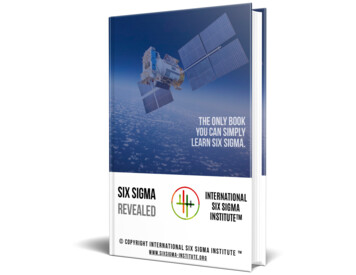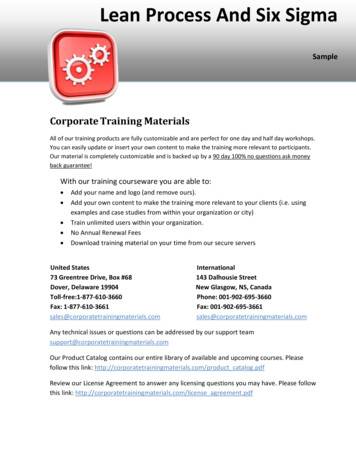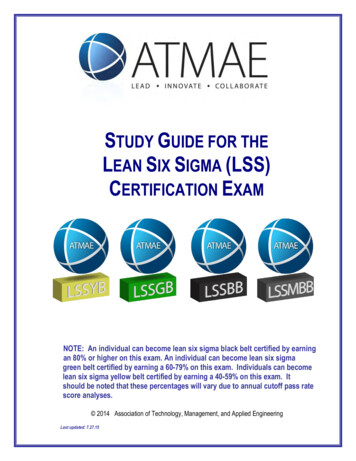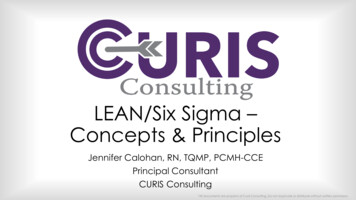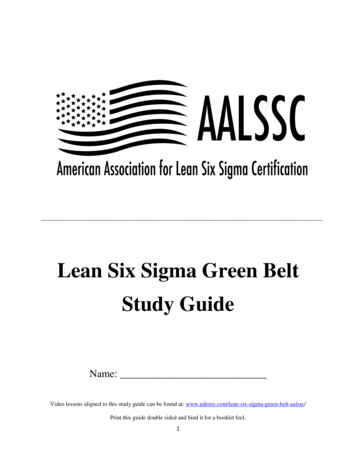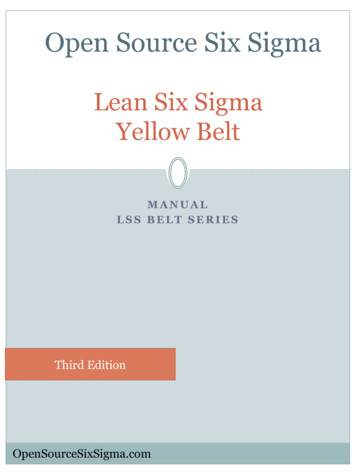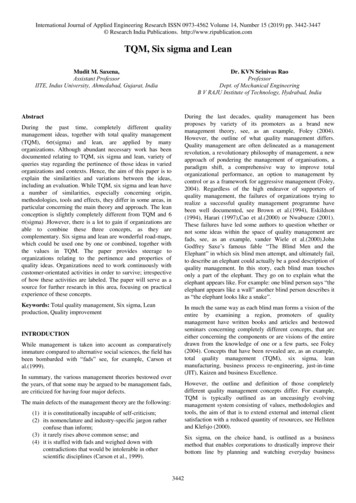
Transcription
International Journal of Applied Engineering Research ISSN 0973-4562 Volume 14, Number 15 (2019) pp. 3442-3447 Research India Publications. http://www.ripublication.comTQM, Six sigma and LeanDr. KVN Srinivas RaoProfessorDept. of Mechanical EngineeringB V RAJU Institute of Technology, Hydrabad, IndiaMudit M. Saxena,Assistant ProfessorIITE, Indus University, Ahmedabad, Gujarat, IndiaDuring the last decades, quality management has beenproposes by variety of its promoters as a brand newmanagement theory, see, as an example, Foley (2004).However, the outline of what quality management differs.Quality management are often delineated as a managementrevolution, a revolutionary philosophy of management, a newapproach of pondering the management of organisations, aparadigm shift, a comprehensive way to improve totalorganizational performance, an option to management bycontrol or as a framework for aggressive management (Foley,2004). Regardless of the high endeavor of supporters ofquality management, the failures of organizations trying torealize a successful quality management programme havebeen well documented, see Brown et al.(1994), Eskildson(1994), Harari (1997),Cao et al.(2000) or Nwabueze (2001).These failures have led some authors to question whether ornot some ideas within the space of quality management arefads, see, as an example, vander Wiele et al.(2000).JohnGodfrey Saxe’s famous fable “The Blind Men and theElephant” in which six blind men attempt, and ultimately fail,to describe an elephant could actually be a good description ofquality management. In this story, each blind man touchesonly a part of the elephant. They go on to explain what theelephant appears like. For example: one blind person says “theelephant appears like a wall” another blind person describes itas “the elephant looks like a snake”.AbstractDuring the past time, completely different qualitymanagement ideas, together with total quality management(TQM), 6 (sigma) and lean, are applied by manyorganizations. Although abundant necessary work has beendocumented relating to TQM, six sigma and lean, variety ofqueries stay regarding the pertinence of those ideas in variedorganizations and contexts. Hence, the aim of this paper is toexplain the similarities and variations between the ideas,including an evaluation. While TQM, six sigma and lean havea number of similarities, especially concerning origin,methodologies, tools and effects, they differ in some areas, inparticular concerning the main theory and approach. The leanconception is slightly completely different from TQM and 6 (sigma) .However, there is a lot to gain if organizations areable to combine these three concepts, as they arecomplementary. Six sigma and lean are wonderful road-maps,which could be used one by one or combined, together withthe values in TQM. The paper provides steerage toorganizations relating to the pertinence and properties ofquality ideas. Organizations need to work continuously withcustomer-orientated activities in order to survive; irrespectiveof how these activities are labeled. The paper will serve as asource for further research in this area, focusing on practicalexperience of these concepts.Keywords: Total quality management, Six sigma, Leanproduction, Quality improvementIn much the same way as each blind man forms a vision of theentire by examining a region, promoters of qualitymanagement have written books and articles and bestowedseminars concerning completely different concepts, that areeither concerning the components or are visions of the entiredrawn from the knowledge of one or a few parts, see Foley(2004). Concepts that have been revealed are, as an example,total quality management (TQM), six sigma, leanmanufacturing, business process re-engineering, just-in-time(JIT), Kaizen and business Excellence.INTRODUCTIONWhile management is taken into account as comparativelyimmature compared to alternative social sciences, the field hasbeen bombarded with “fads” see, for example, Carson etal.(1999).In summary, the various management theories bestowed overthe years, of that some may be argued to be management fads,are criticized for having four major defects.However, the outline and definition of those completelydifferent quality management concepts differ. For example,TQM is typically outlined as an unceasingly evolvingmanagement system consisting of values, methodologies andtools, the aim of that is to extend external and internal clientsatisfaction with a reduced quantity of resources, see Hellstenand Klefsjo (2000).The main defects of the management theory are the following:(1) it is constitutionally incapable of self-criticism;(2) its nomenclature and industry-specific jargon ratherconfuse than inform;(3) it rarely rises above common sense; and(4) it is stuffed with fads and weighed down withcontradictions that would be intolerable in otherscientific disciplines (Carson et al., 1999).Six sigma, on the choice hand, is outlined as a businessmethod that enables corporations to drastically improve theirbottom line by planning and watching everyday business3442
International Journal of Applied Engineering Research ISSN 0973-4562 Volume 14, Number 15 (2019) pp. 3442-3447 Research India Publications. http://www.ripublication.comall employees in the firm actively participate. Shiba et al.(1993), on the other hand, argue that: TQM is an evolvingsystem of practices, tools, and training methods for managingcompanies to provide client satisfaction in an exceedinglyapace dynamic world. Hellsten and Klefsjo (2000) support thethought that TQM is an evolving system. Hellsten and Klefsjo(2000) summarize Total Quality Management as a endlesslyevolving management system consisting of values,methodologies and tools, the aim of which is to raise externaland internal customer agreement with a reduced amount ofresources.activities in ways that minimize waste and resources whereasincreasing client satisfaction by a number of its proponents,see Magnusson et al. (2003).NIST (2000) defines lean as a scientific approach tocharacteristic and eliminating waste through continuousimprovement, flowing the product at the pull of the customerin pursuit of perfection. While the definitions of TQM, sixsigma and lean dissent, the aim of the various ideas looks tobe similar; through enhancements minimizing waste andresources whereas rising client satisfaction and financialresults. These ideas even have a similar origin, the qualityevolution in Japan after the second World War, seeDahlgaard and Dahlgaard (2001).Methodologies and ToolsHellsten and Klefsjo (2000) disagreed that methodologies are“ways to figure at intervals the organisation to attain thevalues”. Tools that are oftentimes mentioned within the TQMliterature embrace the seven internal control tools, seeShewhart (1980) and Ishikawa (1985), and the sevenmanagement tools, see Mizuno (1988). The improvementcycle is additionally a typical methodology so as to enhancethe business, according to Evans and Lindsay (1996). Theimprovement cycle consists of 4 stages: set up, do, study andact (PDSA).TQM, SIX SIGMA AND LEANWith parallels to the fable described above, one could arguethat different promoters in the field of quality management(the six blind men), who each describes different qualitymanagement concepts (the wall, snake, etc.), are trying toexplain a part or a vision in relation to the whole; the area ofquality management (the elephant). However, the componentsor the visions concerning the entire disagree, according to thedefinitions contributed of TQM, Six Sigma and lean (whichalso was the case for the six blind men). On the opposite hand,and as shown on top there also are several similarities forinstance, with relevance the general aim and origin. Therefore,one may additionally argue that the various promoters (the sixblind men) in some areas are ready to describe the same visionof the complete (a similar image of the elephant). Hence, andin outline, this paper sets out to describe if the vision of thedifferent promoters of quality management concepts (TQM,six sigma and lean) is the same or if it differs. Althoughconsiderable progress has been made in the field of qualitymanagement in general and in TQM, six sigma and lean inparticular, many important issues remain unexploredconcerning the similarities and differences between theseconcepts. Hence, the aim of this paper is to explainsimilarities and variations between TQM, six sigma and lean.EffectsVokurka et al. (2000) argue that, with customers rigorousquality and competitors responding to such demands, businessturned to TQM because the key to reinforce overallperformance. There are many different approaches toevaluating the possible benefits of TQM. Historically, one ofthe most common ways to quantify the benefits of quality hasbeen to estimate the costs of poor quality, see, for example,Juran (1989) and So rqvist (1998). In recent years, researchhas also shown that one of the goals of TQM, customersatisfaction, has a significant positive impact on market valueas well as accounting returns, see, for example, Anderssonand Fornell (1994) and Eklo et al. (1999). The GeneralAccounting Office (GAO) study was one of the first studiestrying to establish a link between TQM practices and theperformance of companies, see GAO (1991).In specific, similarities and differences concerning areas suchas the methodologies, tools, effects are illuminated in thispaper. Furthermore, an overall explanation of each notion iscontributed in this paper.In the study, Malcolm Baldrige recipients and organizationsthat had received a site-visit (i.e. companies were near toreceiving an award) were evaluated. The main conclusionfrom the Government Accounting Office study was that thebusinesses investigated had improved their in operationresults. Moreover, better employee relations and improvedoperating procedures had been achieved, greater customersatisfaction had been accomplished, and an increased marketshare and profitability had been gained.Quality management conceptsTotal quality management (TQM)Quality has been an important issue for organizations formany years. The early knowledge in quality evolved fromreview to internal control and later to quality assurance,according to Dale (1999). During the Nineties, TQM evolvedas a typical term among organizations. Different definitions ofTQM are given over the years. Dahlgaard et al. (1998) readTQM as a company culture characterized by accumulatedclient satisfaction through continuous improvement, in whichHendricks and Singhal (1997) and Eriksson and Hansson(2003) compare recipients of quality awards with totallydifferent control corporations. The main conclusions fromtheir research are that companies that have received a quality3443
International Journal of Applied Engineering Research ISSN 0973-4562 Volume 14, Number 15 (2019) pp. 3442-3447 Research India Publications. http://www.ripublication.comalready existing processes and one for new processes. Thefirst methodology wont to improve it in nursing existingmethod are often divided into 5 phases, see Pyzdek (2003)and Magnusson et al.(2003).award outperform the control companies concerning operatingincome-based measures and other indicators during a periodthat follows the announcement. For instance, the growth inoperating income for recipients averaged 91 per cent during aperiod that followed the award announcement, in contrast to a43 per cent average growth for the control groups, seeHendricks and Singhal (1997). Lemak ANd Reed (1997)conjointly claim that TQM ends up in an improved margin ofprofit, after studying 60 companies that had demonstrated acommitment to TQM for a period of at least five years.These are:(1) DefineDefine that method or product that desires improvement.Define the most appropriate team members to figure with thedevelopment. Describe the customers of the course, theirneeds and requirements, and create a map of the process thatshould be improved.Six sigma(2) MeasureIn 1988, Motorola received the Malcolm Baldrige NationalQuality Award, that led to anaugmented interest of six sigmain alternative organisations, see Pyzdek (2001). Today, varietyof worldwide organisations have developed six sigmaprogrammes of their own and 6 sigma is currently establishedin nearly each business. Six sigma is outlined as a businessmethod that enables firms to drastically improve their bottomline by coming up with and observance everyday businessactivities in ways in which minimise waste and resourceswhereas increasing client satisfaction by a number of itsproponents, see Magnusson et al. (2003). Six sigma may evenbe delineated as an improvement programme for reducingvariation, that focuses on continuous and breakthroughenhancements. Improvement comes are driven in a very bigselection of areas and at totally different levels ofcomplexness, so as to scale back variation. The main idea ofreducing disparity on a product or a service is to satisfycustomers. The goal of Six Sigma is that solely 3.4 of amillion customers should be unsatisfied, see Magnusson et al.(2003).Identify the key factors that have the foremost influence onthe method, and decide upon how to measure them.(3) AnalyseAnalyse the factors that need improvements.(4) ImproveDesign and implement the most effective solution. Costbenefit analyses should be used to identify the best solution.(5) ControlVerify if the implementation was sure-fire and make sure thatthe development sustains over time.The second methodology is usually used once the presentprocesses don't satisfy the shoppers or aren't ready toaccomplish strategic business objectives, see Eckes (2001).This methodology may also be divided into 5 phases; outline,measure, analyze, design, verify, according to Magnusson etal. (2003). In summary, the 2 totally different methodologieshave obvious similarities. There are sometimes many variousimprovement tools utilized in a 6 (sigma) programme.Magnusson et al. (2003) document that the 6 (sigma) toolchest contains the seven style tools, the seven statistical tools,the seven project tools, the seven lean tools, the sevencustomer tools, the seven internal control tools and also theseven management tools. The tools are typically straightforward to use in each in progress and breakthroughimprovement comes, however there also are some additionaladvanced applied math tools within the tool chest.Methodologies and toolsHenderson and Evans (2000) claim that the main parts for asucessful 6 (sigma)implementation are managementinvolvement, organisation, infrastructure, training andstatistical tools. Eckes (2001) also points out the importanceof having an infrastructure before starting an improvementprogramme, like six sigma, and further claims that “successfulorganisations use a model for improvement” relatively inoperation impromptu whereas not a model. One of the mostimportant issues of the infrastructure is the involvement of themanagement, see Eckes (2001). Panda et al. (2000) mean thatthe organization additionally should clarify the various rolesneeded and their different areas of responsibility so as toachieve success with a 6 (sigma) programme. According toMagnusson et al. (2003), the hierarchy of responsibilities andthe roles are: Champions and Sponsors, Master Black Belts,Black Belt, Green Belt, White Belt. Sanders and Hild (2000)claim that 6 (sigma) organisations often have standardisedtraining courses, ranging from comprehensive courses forBlack Belts to basic courses for White Belts. There are 2major improvement methodologies in six sigma, one forEffectsMuch of the increased interest in six sigma programmes is dueto the positive financial impact some companies claim that theprogrammes have. For example, Volvo Cars in Sweden claimsthat the six sigma programme has contributed with over 55million euro to the bottom line during 2000 and 2002, seeMagnusson et al. (2003). Another company that has beensure-fire with their 6 (sigma) is that the Business Unit ofTransmission & Transportation Networks at Ericsson set in3444
International Journal of Applied Engineering Research ISSN 0973-4562 Volume 14, Number 15 (2019) pp. 3442-3447 Research India Publications. http://www.ripublication.commanagement. Tools used include Kanban cards for pullthrough the supply chain and therefore the closely connectedJIT system for inventory reduction.Boras, Sweden. Ericsson in Boras has about 1,100 employees.According to Peter Hayhanen, a promoter and educator atEricsson, they started their six sigma programme in 1997.AtEricsson, 6 (sigma) was initially outlined as a technique forfinding issues.EffectsToday, they rather see 6 (sigma) as a business excellencemodel for concrete areas and as a technique so as to succeedin business goals. At Ericsson in Boras, about fifty Black Beltprojects and two hundred Yellow Belt projects are executedbetween 1997 and 2004, with total savings of roughly 200300 million monetary unit between 1997 and 2003. (Thecompany admits it is very difficult to estimate the savings dueto the fact that they do not measure the total savingsanymore.)There are quite a few reasons to introduce lean techniques inrelated organisation, as it may contribute substantially tocutting costs and providing competitive advantages. Leanedges embrace reduced work-in-process, magnified inventoryturns, magnified capability, cycle-time reduction andimproved customer satisfaction. According to a recent survey,see agency (2003), of forty corporations that had adopted leanproducing, typical improvements are visible in three areas.These improvement areas embrace operational enhancements(reduction of some time interval, increase in productivity,reduction in work-in-process inventory, etc.), administrativeimprovements (reduction in order processing errors,streamlining of customer service functions so customers aren'tany longer placed on hold, etc.) and strategic enhancements(reduced prices, etc.).LeanMethodologies and toolsLean principles are basically client worth driven, which makesthem appropriate for many manufacturing and distributionsituations.Five basic principles of lean producing are usuallyacknowledged:Origin and theoryEven though TQM, 6 (sigma) and lean have identical origin(the quality evolution in Japan), the concepts have developeddifferently. Total Quality Management become a very popularconcept in the beginning of the 1990s among researchers andpractitioners in order to describe how organizations shouldwork to gain better performance and customer satisfaction.TQM is usually related to the outstanding figures at intervalsthe sphere of quality management, as an example, Demingand Juran, but they have in general not used the term TQM.(1) Understanding customer valueOnly what the shoppers understand as worth is vital.(2) Value stream analysisHaving understood the value for the customers, the next stepis to analyze the business processes to determine which onesactually add value. If this action doesn't add worth, it shouldbe modified or eliminated from the process.(3) FlowThe success with 6 (sigma) at Motorola and with lean atToyota may be a main reason for these concepts to spread toother organizations. In contrast to six sigma and lean, noorganization was the origin to the term TQM (there is inprogress discussion on United Nations agency really labeledTQM). A notable distinction between 6 (sigma) and lean isthat Motorola labeled Six Sigma , see Rancour andMcCracken (2000), while authors in the field, Womack et al.(1990), labeled the lean concept. George et al. (2004) claimthat the main difference between 6 (sigma) and lean is thatthe previous focuses additional on accomplishing no defects,while the latter is a better choice when one wants to improveprocess flow and eliminate waste. TQM also has elements ofaccomplishing no defects and eliminate waste, but with themain objectives to increase external and internal customersatisfaction with a reduced quantity of resources, see Hellstenand Klefsjo (2000).Focus on organizing a constant flow through the production orsupply chain relatively than moving commodities in largebatches.(4) PullDemand chain management restricts from producing wares tostock, i.e. customer demand pulls finished products throughthe system. No work is conceded out except the result of it isrequired downstream.(5) PerfectionThe elimination of non-value-adding components (waste) maybe a method of continuous improvement. “There isn't anyfinish to reducing time, cost, space, mistakes, and effort”(McCurry and McIvor, 2001).Lean principles don't perpetually apply, however, once clientdemand is unstable and unpredictable. The most componentsconducive to the elimination of non-value-added activities arethe following: excess production, excess process, delays,transport, inventory, defects and movement. A variety ofapproaches are available for reducing or eliminating waste.These approaches include value stream analysis, totalproductive maintenance, Kaizen cost accounting and valueanalysis, engineering and change management, and documentProcess view and approachThe improvement comes during a 6 (sigma) programme areconducted during a wide selection of areas and at totallydifferent levels of quality so as to cut back variation, seeMagnusson et al. (2003). When the project members have3445
International Journal of Applied Engineering Research ISSN 0973-4562 Volume 14, Number 15 (2019) pp. 3442-3447 Research India Publications. http://www.ripublication.comthey realized that the two concepts complemented each othervery well, i.e. lean producing addresses method flow andwaste whereas 6 (sigma) addresses variation and style.reduced the variation in a process, and hence achieved thebusiness goals, increased the profit or lowered the cost, thisimprovement is visualized to the top managers at thecompany. Frequently some of the top managers are alsoinvolved in the performed development projects. As a result,the six sigma programme receives necessary support from thehighest managers at the corporate, as the managers recognisethe economical impact of it. This could be one explanation forthe documented successes of six sigma compared with TQM,i.e. six sigma programmes speak the highest managers’language (the economical gains of the improvement). Lean,on the opposite hand, could be a discipline that focuses onmethod speed and potency, or the flow, in order to increasethe customer value; see George et al. (2004). In leanproducing, project groups are usually the approach to performthe necessary improvements. While six sigma and leanspecialize in playacting enhancements mainly through comes,TQM has sometimes a different approach. TQM emphasizesthe commitment and involvement of all employees, see, forexample, Bergman and Klefsjo (2003). In TQM, there'sconjointly, like 6 (sigma) and lean, a powerful specialise inprocesses. It is the authors’ view that the main aims of theprocess work within Total QualityManagement are toalternatively improve and uniform the processes.This paper has targeted on a theoretical description andcomparison of 3 quality management ideas. Further researchin this area will need to focus on the practical experience ofthese concepts, and contribute to a better understandingconcerning which concept is most appropriate in differentsituations. Furthermore, a more detailed description of howthese concepts can be combined needs to be presented in orderto facilitate for organizations to meet and exceed the demandsof future customers and survive in an excellent additionalcompetitive setting.CONCLUSIONSThe purpose of this paper is to explain similarities andvariations between TQM, six sigma and lean. With parallels tothe fable represented higher than, one could argue that theblind men’s visions about the whole are very similar; the threepresented concepts have many similarities, especiallyconcerning origin, methodologies, tools and effects. However,the blind men’s vision concerning the full additionally differsslightly in some areas; particularly regarding the most theory,approach and the main criticism. Comparing the differentquality management concepts, TQM and 6 (sigma) showmany similarities, while the lean concept is slightly differentcompared to the previous two. However, it's the authors’recommendation that there's plenty to realize if organizationsare able to mix these 3 ideas. Indeed, the concepts arecomplementary; especially 6 (sigma) and lean are excellentroad-maps, which could be used one by one or combined, inorder to strengthen the values of TQM within an organization.Even if a number of the conferred ideas are suspect for beingmanagement fads, it's the authors’ opinion that organizationsincessantly have to be compelled to work with customerorientated activities in order to survive; irrespective of howthese activities are labeled today and in the future.DISCUSSIONSThe conferred ideas show several similarities, particularly6 (sigma) and TQM. However, the package of quality tools,the attention to financial result, the sustaining of the gains,and the focus of the problem solving methods of projects arenew approaches in six sigma compared to different ideas inquality management. Klefsjo et al. (2001) argue that 6 (sigma) ought to be thought to be a technique among thelarger framework of TQM. One reason for this can be becauseof the actual fact that six sigma supports all the six values inTQM, see Klefsjo et al. (2001). Dahlgaard and Dahlgaard(2001) additionally state that there's not any contradictionbetween the objectives in lean and TQM. They support thestudy conferred by Klefsjo et al. (2001) above, and argue thatsix sigma and lean should rather been seen as a collection ofconcepts and tools, which support the overall principles andaims of TQM. Dahlgaard and Dahlgaard (2001) mean that6 (sigma) and lean have clear road-maps so as to attainbusiness excellence, but it is important in order to besuccessful to stress the company culture and human thinkabout these ideas. TQM is often accused for being blur andunclear, and it is, therefore, the authors’ opinion that6 (sigma) and lean can be appropriate approaches fororganizations in order to make vital progress within the fieldof quality management. Recently, the term lean 6 (sigma) hasbeen recommend by, for example, George et al. (2004) andMartichenko (2004). In specific, George et al. (2004) claimthat: Lean 6 (sigma) helps corporations flourish in a very newworld wherever customers expect no defects and quickdelivery at the lowest price. Magnusson et al. (2003)additionally state that several corporations have incorporated6 (sigma) and lean producing practices. The merger can betraced back to early developments at General Electrics whereREFERENCES3446[1]Andersson, E.W. and Fornell, C. (1994), “Customersatisfaction, market share, and profitability: findingsfrom Sweden”, Journal of Marketing , Vol. 58 No. 3, pp.53-66.[2]Bergman, B. and Klefsjo, B. (2003), Quality fromCustomer Needs to Customer Satisfaction , 2nd ed.,Studentlitteratur, Lund.[3]Boaden, R.J. (1997), “What is total quality managementAnd does it matter?”, Total Quality Management , Vol.8 No. 4, pp. 153-71.[4]Brown, M.G., Hitchcock, D.E. and Willard, M.L.(1994), Why TQM Fails and What to do about itIrwinProfessional Publishing, New York, NY.
International Journal of Applied Engineering Research ISSN 0973-4562 Volume 14, Number 15 (2019) pp. 3442-3447 Research India Publications. http://www.ripublication.com[5]Cao, G., Clarke, S. and Lehaney, B. (2000), “Asystematic view of organisational change andTQM”,The TQM Magazine , Vol. 12 No. 3, pp. 186-93.[6]Carson, P.P., Lanier, P.A., Carson, K.D. andBirkenmeier, B.J. (1999), “A historical perspective onfad adoption and abandonment”, Journal of ManagementHistory , Vol. 5 No. 6, pp. 320-33.[7]Cusumano, M.A. (1994), “The limits of lean”, SloanManagement Review , Vol. 35 No. 4, pp. 27-32.[8]Dahlgaard, J.J. and Dahlgaard, S.M.P. (2001), “Leanproduction, six sigma quality, TQM and companyculture – a critical review”, Conference Proceedingsfrom the International Shanghai Quality Symposium,November[9]Dahlgaard, J.J., Kristensen, K. and Kanji, G.K. (1998),Fundamentals of Total Quality Management , Chapman& Hall, London3447
While TQM, six sigma and lean have a number of similarities, especially concerning origin, methodologies, tools and effects, they differ in some areas, in particular concerning the main theory and approach. The lean conception is slightly completely different from TQM and 6 (sigma


